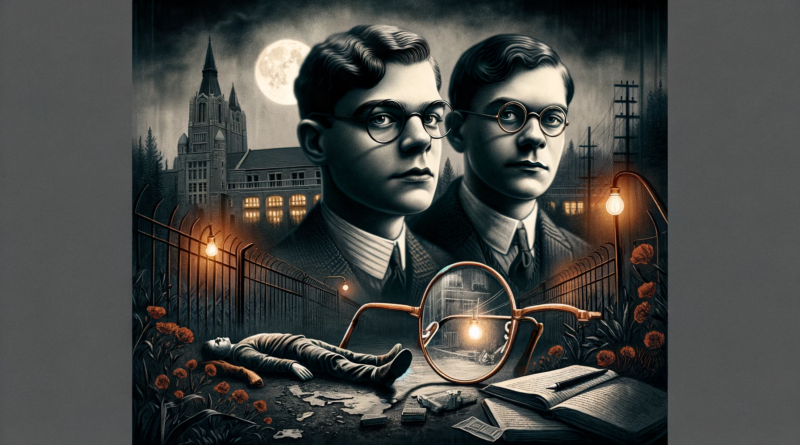The Sinister Genius of Leopold and Loeb: A Chilling Tale of Intellectual Arrogance
In the summer of 1924, two young men from Chicago, Nathan Leopold and Richard Loeb, executed a crime that would shock the nation and forever etch their names into the annals of American criminal history. This story is not merely one of murder; it is a tale of intellectual arrogance, moral detachment, and the dark allure of power. Their meticulously planned crime and subsequent trial would become a grim reminder of how brilliance can be corrupted into malevolence.

The Prodigies
Nathan Leopold and Richard Loeb were not ordinary criminals. Born into wealthy families, they had access to the best education money could buy. Leopold, 19, was a child prodigy with an IQ above 200. By the time of the crime, he had already earned a degree from the University of Chicago and was an avid ornithologist, fluent in multiple languages. Loeb, 18, was equally gifted, having become the youngest graduate in the history of the University of Michigan. Despite their intellectual prowess, both were deeply troubled individuals.
Leopold was fascinated by Friedrich Nietzsche’s concept of the “Übermensch” or “superman,” believing that he and Loeb were above the moral constraints that governed ordinary people. Loeb, on the other hand, was driven by a need for excitement and validation. Their friendship, while intense, was marked by manipulation and a shared delusion of grandeur.
The Perfect Crime
Driven by their belief in their own superiority, Leopold and Loeb set out to commit the perfect crime, one that would demonstrate their intellectual prowess and confirm their self-perceived status as Nietzschean supermen. They meticulously planned the kidnapping and murder of Bobby Franks, Loeb’s 14-year-old second cousin and neighbor. The choice of victim was chillingly arbitrary, underscoring their complete detachment from human empathy.

On May 21, 1924, they lured Bobby into their rented car under the pretense of giving him a ride home. Once inside, Loeb struck Bobby with a chisel, killing him almost instantly. They then drove to a remote area near Wolf Lake in Indiana, where they disposed of his body in a culvert and poured hydrochloric acid on his face and genitals to obscure his identity. The next day, they sent a ransom note to Bobby’s parents, demanding $10,000.
The Downfall
Despite their careful planning, Leopold and Loeb’s intellectual hubris led to their downfall. A pair of eyeglasses with a distinctive hinge mechanism was found near Bobby’s body. These glasses were traced back to Leopold, as only three pairs of that particular design had been sold in Chicago, one of which belonged to him. When questioned, both Leopold and Loeb initially tried to maintain their innocence but quickly cracked under pressure and confessed to the crime in chilling detail.

Their confessions revealed the extent of their planning and their complete lack of remorse. They described their actions with clinical detachment, emphasizing their belief in their intellectual superiority and their right to commit such an atrocity.
The Trial
The trial of Leopold and Loeb became a media sensation, drawing intense public interest and extensive coverage. Renowned attorney Clarence Darrow was hired to defend them, and he mounted a defense that would become legendary. Darrow did not dispute their guilt; instead, he focused on saving them from the death penalty.

In his impassioned 12-hour-long closing argument, Darrow argued against the death penalty on moral and psychological grounds. He highlighted their youth, their psychological instability, and the influence of Nietzschean philosophy on their actions. Darrow’s plea for mercy was a powerful indictment of the death penalty and a call for understanding the deeper causes of crime.
On September 10, 1924, Judge John Caverly sentenced Leopold and Loeb to life imprisonment for the murder plus 99 years for the kidnapping, sparing them the death penalty. This verdict was seen as a victory for Darrow and a profound statement on the nature of justice.
Leopold and Loeb were incarcerated at the Joliet Prison before being transferred to Stateville Penitentiary. Their prison lives took different trajectories. On January 28, 1936, Loeb was assaulted by fellow inmate James Day with a straight razor in a shower room, leading to his death shortly after in the prison hospital. Day alleged that Loeb had attempted to sexually assault him, yet Day remained unscathed while Loeb suffered over fifty wounds, including defensive ones on his arms and hands, with his throat slashed from behind. Although prison officials, including the Warden, suspected foul play, Day was acquitted by a jury in June 1936 following a brief trial.

Speculation arose regarding a potential sexual motive behind the killing. While some reports suggest that newsman Ed Lahey began his Chicago Daily News story with the lead, “Richard Loeb, despite his erudition, today ended his sentence with a proposition,” there is no evidence to support the publication of this lead. Actual copies from that date provide a different account.
Leopold, on the other hand, sought redemption through service and self-improvement. He became an exemplary prisoner, organising educational programs, teaching classes, and working in the prison hospital.
Published in 1958 as part of his efforts to secure parole, Leopold’s autobiography, “Life Plus 99 Years,” quickly gained traction. It enjoyed a 14-week stint on the New York Times Best Seller list and garnered predominantly favorable reviews. However, some critics argued that Leopold’s narrative was an attempt to whitewash his past and reshape his public image, disregarding the darker aspects of his history.
His efforts earned him parole in 1958 after 33 years in prison. Upon his release, Leopold moved to Puerto Rico, where he quietly lived out his remaining years working in social services and engaging in medical research until his death in 1971.
